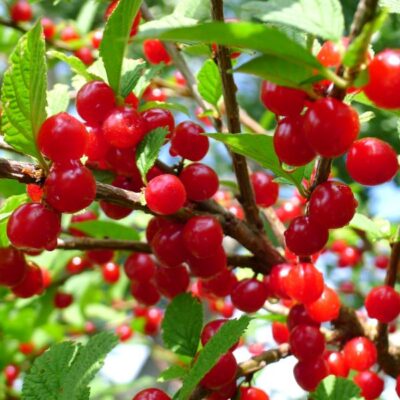Garden Plant: Nanking Cherry
Product Description: Nanking Cherry

Spring Beauty and Delicious Fruit Nanking Cherry
- Beautiful, Hardy Edible Ornamental Shrub
- Profusion of Fragrant White Flowers in Early Spring
- Tasty, Abundant Bright Red Fruit
- Wide Shrub or Small Tree
- Extremely Cold Tolerant
- Use as a Special Hedge or Specimen
- Pest and Disease Resistant
- Tolerant of Periodic Drought
- Feed Songbirds or Harvest Nanking Cherries for Pies, Jelly and Wine
- Great Choice for Nature Lovers and Foodies in Cold Climates
For homeowners in the cold winter zones from 2 – 6, Nanking Cherry (Prunus tomentosa) is a wonderful, easy-care bush to add to the landscape. You’ll love the fruit’s tangy, sweet-tart taste for fresh eating or baking into pies.
The spring flowers are spectacular! Rosy pink buds cover the shrub in early spring, and open to showy white flowers. This reliable early bloomer is so welcome after the long winter.
The flowers are both fragrant and frost tolerant, which makes this plant a true harbinger of spring. Of course, the white blooms are also a welcome nectar source for butterflies and pollinators.
Nanking Cherry has a long history of proving delicious red fruit in harsh climates. The berries seem to glow against the attractive, textured foliage. Each cherry is a brilliant, translucent red jewel.
Use it as a long hedge along a fence or a single specimen. Or, create an orchard in a backyard homestead. This is the earliest Cherry to flower, and it produces an abundance of tasty cherries.
Nanking Cherry is not reliably self-fertile. To achieve fruit set, plant two or more shrubs close by each other to ensure proper cross-pollination for the best fruit production.
Plan to start harvest as they ripen in early to mid-summer, depending on your location. Or, just leave them for your local bird population. It’s a win-win either way!
We’ll tempt you to harvest some for yourself, as many people swear by the Nanking for wine and mead production. Or, use it to craft beautiful clear jellies and wonderful jams. You’ll find pages of recipes for Nanking Cherry on the Internet. It would take years just to try them all.
The highly-textured, quilted, dark green, toothed leaves are decorative in their own right. They are downy on the underside. The soft-textured foliage turns a soothing yellow in the fall.
Even the bark is beautiful, lustrous and ornamental. It delivers visual interest in winter as it exfoliates to show pattern variation of shiny reddish-brown bark peeling to orange as it ages.
This is a great conversation plant with fragrant blooms, attractive soft green foliage and wonderful bright red fruit. In time, this plant develops a picturesque rounded form in the landscape.
How to Use Nanking Cherry in the Landscape
Use it for massing in a hedge or planted on a slope. Include it in your mixed borders as a lovely backdrop for smaller plants. Or, plant two or three shrubs together for a fabulous fruiting specimen to create a marvelous focal point in a lawn planting.
The soft features make it the perfect accent along a driveway or running along a fence. Add it to windbreaks for color, fragrance, fruit and to add charm and personality.
Nanking Cherry has tremendous value for screening and hedging. Plant them 6 – 8 feet apart to create a free-form, natural hedge. Measure from the center of the first shrub to the center of the next.
If desired, the Nanking Cherry can be pruned into a single trunk tree, or a multi-trunk specimen for a focal point in the landscape.
For a special treat in mid-winter, cut several branches and bring them indoors. You can force them to bloom in sunny spot. Just arrange the branches in a tall vase and change the water daily. You’ll thrill to seeing the buds open indoors.
Easily create a wildlife habitat with several Nanking Cherry bushes added to anchor a Butterfly Garden. The birds, butterflies and pollinators will thank you!
Pro Plant Tips for Care
This plant is very well-known in the Asian Far East, where it’s found in most home gardens and on commercial plantations throughout Russia. A heavy usage means there are a lot of common names. You might hear Downy Cherry, Mountain or Mongolian Cherry, Hedge Cherry, Chinese Bush Cherry or Manchu Cherry.
Whatever you call it, it’s a hard-working landscape plant with a lot of ornamental features. This tough plant is really useful in areas where hardy plants are required, but few are available. Nanking Cherry is the earliest-blooming Cherry and one of the best producers for extreme temperature areas.
Brought to the United States in 1882, the plant’s cold hardiness, early-blooming along with its natural dwarfing, were all considered exciting traits.
The yummy fruit is too soft for most commercial purposes, and is not often available any other way than growing your own. Eat them fresh, or prepare into pie filling, make jams or jelly or freeze them.
The Nanking Cherry adapts to a variety of soil conditions and pH levels. Give it a full sun location and well-drained soil for best results. Be careful to water it regularly while the plant is young.
Nanking can handle periodic drought, once it’s established in your native soil. This is a great choice for semi-arid climates with cold winters and hot summers.
Prune Nanking Cherry to thin out dead and diseased branches after fruiting is done. Open the center of the plant to sunshine and air circulation each year.
If you are looking for a plant that is beautiful, helps wildlife, and can give you fruit as well, this is a great choice. Order Nanking Cherry today.


